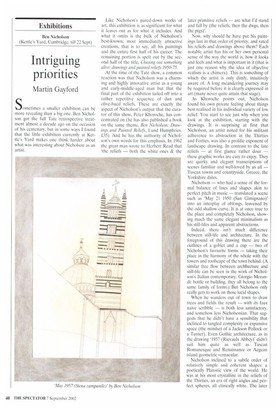Intriguing priorities
Martin Gayford
Sometimes a smaller exhibition can be more revealing than a big one. Ben Nicholson got the full Tate retrospective treatment almost a decade ago on the occasion of his centenary, but in some ways I found that the little exhibition currently at Kettle's Yard makes one think harder about what was interesting about Nicholson as an artist.
Like Nicholson's pared-down works of art, this exhibition is as significant for what it leaves out as for what it includes. And what it omits is the bulk of Nicholson's best-known, most immediately attractive creations, that is to say, all his paintings and the entire first half of his career. The remaining portion is spelt out by the second half of the title, Chasing out something alive: drawings and painted reliefs 1950-75.
At the time of the Tate show, a common reaction was that Nicholson was a charming and highly innovative artist as a young and early-middle-aged man but that the final part of the exhibition tailed off into a rather repetitive sequence of dun and olive-hued reliefs. These are exactly the aspect of Nicholson's output that the curator of this show, Peter Khoroche, has concentrated on (he has also published a book on the same theme, Ben Nicholson: Drawings and Painted Reliefs, Lund Humphries, £35). And he has the authority of Nicholson's own words for this emphasis. In 1962 the great man wrote to Herbert Read that 'the reliefs — both the white ones & the later primitive reliefs — are what I'd stand and fall by (the reliefs, then the dwgs, then the ptgs)'.
Now, why should he have put his paintings last in that order of priority, and rated his reliefs and drawings above them? Each notable artist has his or her own personal sense of the way the world is, how it looks and feels and what is important in it (that is just one reason why the idea of objective realism is a chimera). This is something of which the artist is only dimly, intuitively aware of. A long meandering journey may be required before it is clearly expressed in art (many never quite attain that stage).
As Khoroche points out, Nicholson found his own private feeling about things best realised in his individual variety of low relief. You start to see just why when you look at the exhibition, starting with the drawings. It is surprising at first that Nicholson, an artist noted for his militant adherence to abstraction in the Thirties and Forties, was also a prolific exponent of landscape drawing. In contrast to the late
reliefs — at first glance rather dour these graphic works are easy to enjoy. They are quirky and elegant transcriptions of scenes familiar and well-loved by us all — Tuscan towns and countlyside, Greece, the Yorkshire dales.
Nicholson — who had a sense of the formal balance of lines and shapes akin to perfect pitch in music — translated a scene such as 'May 21 1950 (San Gimignario)' into an interplay of oblongs, leavened by the odd shallow curve. It is at once true to the place and completely Nicholson, showing much the same elegant minimalism as his still-lifes and apparent abstractions.
Indeed, there isn't much difference between still-life and architecture. In the foreground of this drawing there are the outlines of a goblet and a cup — two of Nicholson's favourite forms — taking their place in the harmony of the whole with the towers and roofscape of the town behind. (A similar free flow between ardiftecture and still-life can be seen in the work of Nicholson's Italian contemporary, Giorgio Morandi: bottle or building, they all belong to the same family of forms.) But Nicholson only really gets to work on those lucid shapes.
When he wanders out of town to draw trees and fields the result — with its faux naive scribble — is both less satisfactory, and somehow less Nicholsonian. That suggests that he didn't have a sensibility that inclined to tangled complexity or expansive space (the mindset of a Jackson Pollock or a Turner). Even Gothic architecture, as in the drawing '1957 (Rievaulx Abbey)' didn't suit him quite as well as Tuscan Romanesque and Renaissance or Aegean island geometric vernacular.
Nicholson inclined to a subtle order of relatively simple and coherent shapes: a poetically Platonic view of the world. He was at his most crystalline in the reliefs of the Thirties, an era of right angles and perfect spheres, all clinically white. The later


























































 Previous page
Previous page